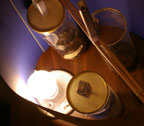

Avoiding Flawed
Demonstrations:
Greenhouse Effect
Intro/Index
Faulty Demos
Errors, Misconceptions
Testing, Lab Results
Scientifically Strong
Resources
Rebuttals
Acknowledgements
Contact

This web portal
is a resource within
America's online library
for Education &
Research
in Science,
Technology,
Engineering,
Mathematics:

|
 |

Introduction and Index Page
Errors, Problems and Misconceptions Common in the Faulty Demonstrations -- Overview
Lack of clarity and accuracy: What are you attempting to demonstrate? What do the results indicate?
Using incandescent light bulbs (or the sun) as the energy source places big challenges -- and duties -- on a presentation
Background and in-depth analysis will be appearing here. Topics include:
Revealing the invisible, or propagating confusion? -- different bands of the energy spectrum. When do gases in the air react, and not react?
How is the outgoing energy from the earth being represented?
Claiming something is "easy" to demonstrate when it isn't. Setting teachers, students, and parents up for failure, doubt, deceit and distrust.
Global warming takes place through several interconnected steps. How many are being represented in your demo?
Understanding or deception? The three forms of heat energy transfer: radiation, convection and conduction.
Not recognizing other properties of carbon dioxide.
Confusing the metaphor with actual scientific phenomenon -- what is "the greenhouse effect".
How do gas containment vessels influence the results? Properties of PETE plastic and glass in various infrared bands.
Signal to noise ratio: how strong a signal is expected; against how much background noise? Would you expect to see a measurable signal?
Accuracy and tolerance of test equipment available to educators.
Avoiding poor lab techniques.
Modeling Earth's atmosphere, with its many layers. Outgoing energy to the cold of outer space.
Experimenter bias. Pressure on teachers to produce a priori results. Demos where results can be easily forced either way.
Bypassing opportunities for exciting discovery, real understanding. Replacing with cheap, inaccurate activities. Token hands-on.
Is it OK to use fake demonstrations? -- "We need to do something hands-on. As long as it advances the right message (sic), what is the harm?"
Some phenomenon are "easy" to demonstrate, even in one step. Others not. Why not break this up into manageable, engaging pieces?
Scientists do not understand global warming as being all in one step, but a series of connected reactions. Students can too -- using great demos.
Nuclear fusion is very real (as in the sun). Everything can't be demonstrated in the classroom. Remember "cold fusion" -- infamous fake demo.
Revealing that many common graphics & diagrams are oversimplified, inaccurate. Want to really understand something? -- try demonstrating it.
Symptoms: When developers blindly copy the work of others, with credit not given. When sponsors want only cheap, token hands-on science.
Walls have been placed between scientists and educators/the public on this. For science education to be strong, we must not be separated.
Many sponsors and promoters steering educators away from quality hands-on science, back to message pipelines under their control.
Why not make well vetted, fun, exciting, education standard aligned demos yours? Don't go down swinging at smoke; hit a home run.
|
|


